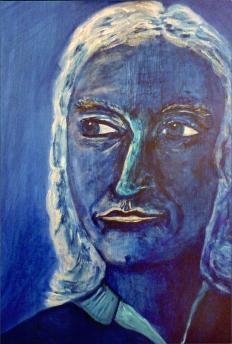
(After Sir James Thornhill)
For laws of motion—Isaac had the three
and so he came up with—gravity.
A body continues to move or to rest
if an outside force isn’t suppressed.
The direction of force accelerates the body—
then he came up with a mathematical key.
Directly proportional to the force it has
and inversely proportional to the body’s mass.
And if you are ready to call it a day,
abbreviate to: F = m a
And then the idea of a basic attraction—
to be found in the equal and opposite reaction.
If you are wanting anything more
there is Newton’s own—Inverse Square Law.
Examine the force of gravity between two masses,
you will find it varies with the bodies’ chassis.
Divide by the square of the distance between them
the force is proportional to that given connection.
To match the inverse square law with elliptical motions
create a new mathematics and call it the “Fluxions.”
When Newton saw Leibniz’ paper—Calculus—he cursed
and he set out to prove that he got there first.
Although he knew his laws would endure
he wanted to unite the laws of Nature.
If you think that Principia is a rare bag of tricks,
in 1704 he published Opticks.
Principia Mathematica summed up celestial mechanics
Newton had given the world new dynamics.
He decided not to publish—Conclusio,
because without proof, it just was not so.
In Conclusio—Newton had in his mind—
of natural forces—there may be more kinds.
If greater bodies had mutual attraction,
then lesser ones would have similar reaction.
If greater motions are easily detected,
then lesser ones should not be rejected.
Of unobserved—”insensible particles”—a suspicion—
but without proof, there would be no revision.
He said more kinds of forces should not be denied
but speculation for Isaac was never applied.
As well as the Universe’s observable motion,
the unobservable type was also a notion.
For Isaac his work was succinct,
there was no place for any instinct.
His methods were a recipe for perfection.
His gift to science—was a new direction.
His motto seemed—“never say as you please”—
for Isaac did not invent hypotheses.
René Descartes, he abruptly dismissed,
when he found vortices could not persist.
Because Newton did not make up hypotheses
Opticks had addenda—with 16 queries.[1]
Number one query—outstanding for instance—
(“Do not bodies act upon light at a distance…”)
This query is definitely one to praise.
(“… and by their action bend its rays?”)
For startling questions—query five is one to tether—
(“Do not bodies and light act mutually upon one another?”)
If you think that Newton has done
consider then query thirty-one—
After gravity, magnetism, electricity if you please !
(“There may be more attractive powers than these…”
For Nature is very consonant and conformable to herself.”)
I advise you not to leave that observation on the shelf !
A subatomic force was almost defined
in Opticks—388 to 389—
(“I had rather infer from their cohesion
that their particles attract one another
by some force which in immediate contact
is exceeding strong.”)
In Opticks 403 to 404—
a fantasy from some folklore?
(“It may also be allowed that God is able to create
Particles of Matter of several sizes and Figures
and in several Proportions to Space and perhaps
of different Densities and Forces, …
and thereby to vary the laws of Nature,
and make worlds of different sorts
in several parts of the Universe.”)
This idea is for me
incredible in its diversity !
If attraction does appeal to you
then read Principia 382
Attraction and repulsion to Newton were known—
and now the whole world would be shown.
(“Particles are attracted and they cohere.
Alternatively they are repelled and don’t come near.”)
For a disappearing trick or two,
then read Principia 442
(“The ultimate ratio of vanishing quantities
is to be understood…
by the ratio with which they vanish.”)
Before and after—you can banish !
For Newton’s work methodology
the first was to—(“inquire diligently.”)
And if you want more common sense—
(“establish properties by experiments.”)
And last but not least—if you follow his notions—
(“proceed more slowly to hypotheses for explanations…”)
Another pertinent comment on science method and proof—
(“For if the possibility of hypotheses is to be the test of truth”)
(“Truth is ever to be found in simplicity
and not in ye multiplicity.”)
And for your further edification—
(“Truth is found in silence and unbroken meditation.”)
Because Isaac may have mellowed with time
he wrote anonymously regarding his prime.
Published in the Journal for students would appear
an explanation of his work from Principia.
Thirty years after its publication date
in 1718 he explained from 1688.
He wanted non-mathematical students to see
that “the systeme of the heavens might be
founded upon good geometry.”
Oh what a man, oh what a mind—
differential and integral calculus defined.
A scientist with a method of elegant evaluation,
he would excavate truth in all information.
Sir Isaac Newton was the pivotal man,
at the place where science and technology began.
He was someone who by his own contemplation,
pursued divergent paths in his education.
There was no disorder in his universal animation.
A man who had determined determination.
In Newton’s book Principia
was a mathematical panacea.
[1] In later editions the 16 queries increased to 31